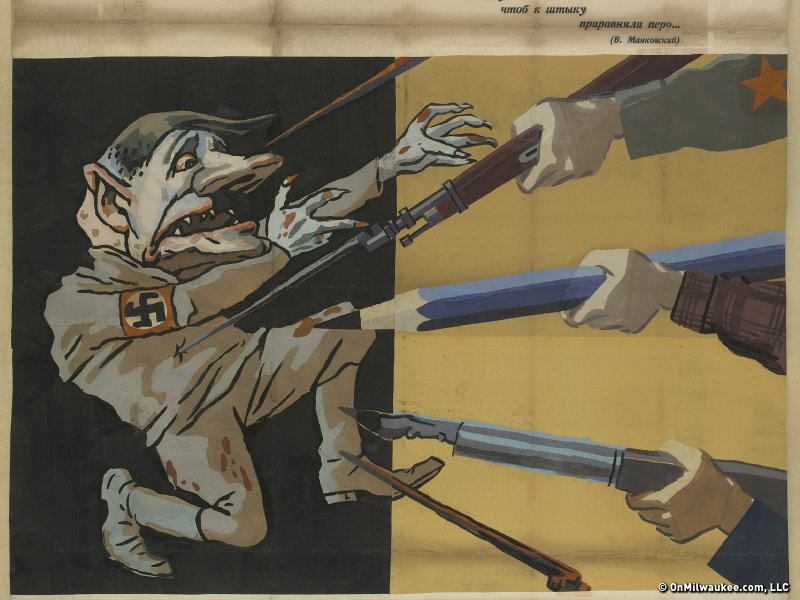From now until Sunday, Oct. 23, visitors to the Art Institute of Chicago (AIC) can enjoy the high-impact propaganda posters created by Soviet artists and writers during World War II. Entitled "Windows on the War: Soviet TASS Posters at Home and Abroad, 1941-1945," the exhibit showcases posters originally mailed to AIC during the war and that haven't been displayed in the U.S. since.
The line, "I want the pen to be on par with the bayonet," from a poem by Bolshevik poet Vladimir Mayakovsky, is writ over three of the powerful posters and serves to summarize the whole exhibit.
The Windows exhibit is part of "The Soviet Arts Experience," which is a 16-month series that started October 2010 and continues into January 2012 and features handwritten memoirs by those imprisoned in Soviet gulags, numerous art shows, film and live musical performances in venues across Chicago.
"Windows on the War" focuses on 157 stenciled posters, designed and created by the members of the Telegraph Agency of the Soviet Union, or "TASS." Windows also includes propaganda pieces from Ne boltai! and many other informative pieces that draw the visitor into the historical moment of this incredible art.
The Windows exhibit begins big with a blown-up photo of the TASS poster office taken by Margaret Bourke-White, American photographer and war correspondent, at the end of a red-painted entry. On the walls of the entryway are two pieces of introductory material entitled "Art as a Weapon" and "The Motherland Calls." The enormity of the entryway space prepares visitors for the size of the posters being exhibited, many of which are close to 10-feet high, yet the exhibit also becomes much more intimate in interior rooms, once people are surrounded by the images.
The posters are so large because they were often displayed in the windows of empty shops around the Soviet Union, hence part of the "Windows on the War" title, along with the ability of the posters to provide windows into Soviet and American relations during the war.
"Windows on the War" includes an explanation of the multi-layered stenciling technique TASS (and earlier Russian artists) used to make the posters, as well as the deeply embedded Russian art forms that were drawn upon to make much of the TASS propaganda.
There is a newsreel of the artists at work in the TASS poster studio, and two films played back-to-back near the end of the exhibit which graphically depict prisoners of war. Many sections of Windows on the War explain the cultural, political and artistic significance of the posters while other sections comment on American responses in propaganda form.
The Nazis were often depicted with claws or clawed hands in the TASS posters. One section in the exhibit provides three examples of how Nazis graphically represented Jews and Soviets in their propaganda.
Visitors should also check out an exhibit entitled "Belligerent Encounters: Graphic Chronicles of War and Revolution, 1500-1945," which runs concurrent with "Windows on the War." Billed as a "prelude" to the Windows exhibit, "Belligerent Encounters" chronicles some of humanity's unfortunately and exceedingly long history with warfare and contextualizes the work of the TASS artists in the Windows exhibit.
The "Belligerent Encounters" exhibit highlights Spanish artist Goya's "Disasters of War" series and discusses its significance both for the TASS poster artists and for others, including German artists Max Beckmann and Otto Dix.
"Belligerent Encounters" includes curious items like a drawing from a medical sketchbook and hard-to-look-at photos of war victims. There is a section from a guest curator which historicizes the pejorative use of the word "Hun," suggesting that Kaiser Wilhelm II first used the term while giving a speech to German soldiers on their way to China during the Boxer Rebellion in 1900, and how that ironically led to its use in dehumanizing Germans ever since.
The most stunning works on display in "Belligerent Encounters" include lithographs of war ruins by Frank Brangwyn and seven drawings in a series of 12 by Heinrich Hoerle. Called the "Cripple Portfolio," Hoerle's drawings chronicle how gawkers stare at war wounded, display how a woman cradles a man's prosthesis while his brow furrows and one drawing depicts a human leg sprouting a tree, suggesting possibilities for peace.
"Windows on the War" is a surprisingly large exhibit and visitors need to set aside a lot of time to see it all. If viewed with "Belligerent Encounters," visitors should certainly get to AIC early in order to get it all in. Of course, just seeing a portion of these exhibits is also worthwhile; their powerful imagery offers enough commentary to ruminate on even in small doses.
Royal Brevväxling is a writer, educator and visual artist. As a photo essayist, he also likes to tell stories with pictures. In his writing, Royal focuses on the people who make Milwaukee an inviting, interesting and inspiring place to live.
Royal has taught courses in critical pedagogy, writing, rhetoric and cultural studies at several schools in Wisconsin and Minnesota. He is currently Adjunct Associate Professor of Humanities at Milwaukee Institute of Art and Design.
Royal lives in Walker’s Point with his family and uses the light of the Polish Moon to illuminate his way home.



